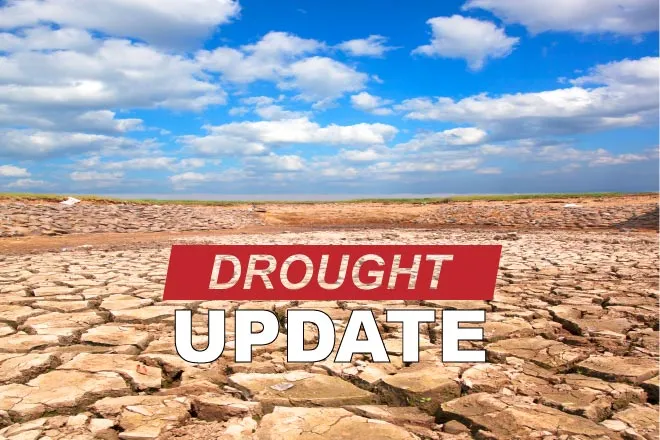
Ag stats: Colorado crop progress and condition report – week ending June 7, 2020
Continued hot and dry weather pushed spring crop development but furthered concerns for moisture needs going forward, according to the Mountain Region Field Office of the National Agricultural Statistics Service, USDA.
Northwestern counties received isolated moisture last week which benefitted pasture conditions. Pasture conditions remained mostly fair to good in areas that have received more consistent moisture.
In northeastern counties, continued hot and windy conditions depleted soil moisture supplies and blowing topsoil was a concern in areas. Elevated fire danger was noted. Isolated severe weather was reported over the weekend. Crop producers were quickly moving to irrigate spring crops which showed signs of stress due to lack of precipitation. Wheat producers noted increased crop stress due to unfavorable weather and more acreage was close to failure. Concern was high for viability of non-irrigated spring crops unless moisture is received. County reports noted some producers were unable to plant spring crops as previously planned due to no received moisture. Pasture conditions also continued to deteriorate, and livestock producers were seeking alternative grazing arrangements.
In east central counties, hot and dry weather prevailed, and concerns were high for irrigated and non-irrigated crop conditions along with pasture. Isolated severe weather was noted in the district with portions of eastern Yuma county receiving damaging hail.
In western counties, severe weather produced very high winds and brought needed moisture to some localities.
The San Luis Valley received welcome rain late in the week, benefitting native pastureland. Potatoes were emerging well, but a report noted barley growth was uneven in areas.
In southeastern counties, scattered showers last week did not produce a lot of moisture. Reports noted livestock producers continued to provide supplemental feeding due to dry conditions and limited pasture growth. Producers were beginning to sell cattle in response to the drought. A county report noted irrigation canal water flow picked up a bit due to late snow melt, but concerns remained due to overall snowpack shortages.
Stored feed supplies were rated 5 percent very short, 17 percent short, 75 percent adequate, and 3 percent surplus.
Sheep death loss was 55 percent average and 45 percent light.
Cattle death loss was 80 percent average and 20 percent light.
CROP AND LIVESTOCK PROGRESS | ||||
Commodity | Current week | Previous week | Previous year | 5-year average |
(percent) | (percent) | (percent) | (percent) | |
Alfalfa hay | ||||
1st cutting harvested | 44 | 25 | 32 | 30 |
Corn | ||||
Emerged | 95 | 84 | 63 | 78 |
Dry edible beans | ||||
Planted | 56 | 31 | 11 | 32 |
Emerged | 17 | 8 | 3 | 12 |
Onions | ||||
Planted | 95 | 92 | NA | NA |
Potatoes inside San Luis Valley | ||||
Emerged | 60 | 43 | 33 | 37 |
Potatoes outside San Luis Valley | ||||
Emerged | 93 | 81 | 80 | 87 |
Proso Millet | ||||
Planted | 79 | 46 | 47 | NA |
Sorghum | ||||
Planted | 56 | 42 | 52 | 47 |
Emerged | 20 | 11 | 13 | 18 |
Sugarbeets | ||||
Emerged | 93 | 74 | 89 | NA |
Sunflowers | ||||
Planted | 51 | 40 | 27 | 23 |
Winter wheat | ||||
Headed | 86 | 67 | 79 | 89 |
Turning color | 10 | 4 | 2 | 14 |
DAYS SUITABLE FOR FIELDWORK AND SOIL MOISTURE CONDITION | ||||
Current week | Previous week | Previous year | 5-year average | |
Days suitable for fieldwork | 6.6 | 6.8 | 5.6 | 5.8 |
Topsoil moisture | (percent) | (percent) | (percent) | (percent) |
Very short | 23 | 22 | 2 | 5 |
Short | 40 | 41 | 7 | 13 |
Adequate | 37 | 36 | 86 | 74 |
Surplus | -- | 1 | 5 | 8 |
Subsoil moisture | ||||
Very short | 22 | 21 | 2 | 5 |
Short | 34 | 34 | 11 | 13 |
Adequate | 44 | 45 | 83 | 78 |
Surplus | -- | -- | 4 | 4 |
CROP, LIVESTOCK, PASTURE AND RANGE CONDITION | ||||
Commodity | Current week | Previous week | Previous year | 5-year average |
(percent) | (percent) | (percent) | (percent) | |
Alfalfa hay | ||||
Very poor | 6 | 5 | 3 | 2 |
Poor | 10 | 9 | 6 | 6 |
Fair | 28 | 25 | 8 | 23 |
Good | 48 | 55 | 63 | 55 |
Excellent | 8 | 6 | 20 | 14 |
Barley | ||||
Very poor | -- | 2 | -- | -- |
Poor | 1 | 4 | 2 | 1 |
Fair | 28 | 23 | 17 | 20 |
Good | 51 | 47 | 60 | 56 |
Excellent | 20 | 24 | 21 | 23 |
Corn | ||||
Very poor | 3 | 1 | -- | -- |
Poor | 9 | 8 | 4 | 2 |
Fair | 36 | 38 | 27 | 20 |
Good | 43 | 44 | 63 | 70 |
Excellent | 9 | 9 | 6 | 8 |
Onions | ||||
Very poor | 2 | 3 | -- | 1 |
Poor | 4 | 4 | -- | 3 |
Fair | 27 | 26 | 13 | 21 |
Good | 62 | 60 | 82 | 65 |
Excellent | 5 | 7 | 5 | 10 |
Pasture and range | ||||
Very poor | 23 | 19 | 1 | 5 |
Poor | 16 | 16 | 2 | 10 |
Fair | 29 | 33 | 15 | 20 |
Good | 32 | 32 | 71 | 54 |
Excellent | -- | -- | 11 | 11 |
Potatoes inside San Luis Valley | ||||
Very poor | -- | NA | NA | NA |
Poor | 5 | NA | NA | NA |
Fair | 25 | NA | NA | NA |
Good | 45 | NA | NA | NA |
Excellent | 25 | NA | NA | NA |
Potatoes outside San Luis Valley | ||||
Very poor | 2 | 2 | -- | -- |
Poor | 3 | 4 | 2 | 1 |
Fair | 21 | 21 | 17 | 11 |
Good | 62 | 62 | 64 | 71 |
Excellent | 12 | 11 | 17 | 17 |
Sugarbeets | ||||
Very poor | 2 | 1 | -- | -- |
Poor | 6 | 5 | 2 | 1 |
Fair | 28 | 30 | 33 | 21 |
Good | 51 | 51 | 52 | 63 |
Excellent | 13 | 13 | 13 | 15 |
Winter wheat | ||||
Very poor | 17 | 20 | 2 | 4 |
Poor | 21 | 21 | 2 | 11 |
Fair | 30 | 28 | 16 | 25 |
Good | 30 | 29 | 59 | 46 |
Excellent | 2 | 2 | 21 | 14 |
Livestock | ||||
Very poor | 1 | 1 | -- | -- |
Poor | 5 | 4 | 4 | 2 |
Fair | 22 | 20 | 16 | 13 |
Good | 62 | 65 | 68 | 72 |
Excellent | 10 | 10 | 12 | 13 |
















